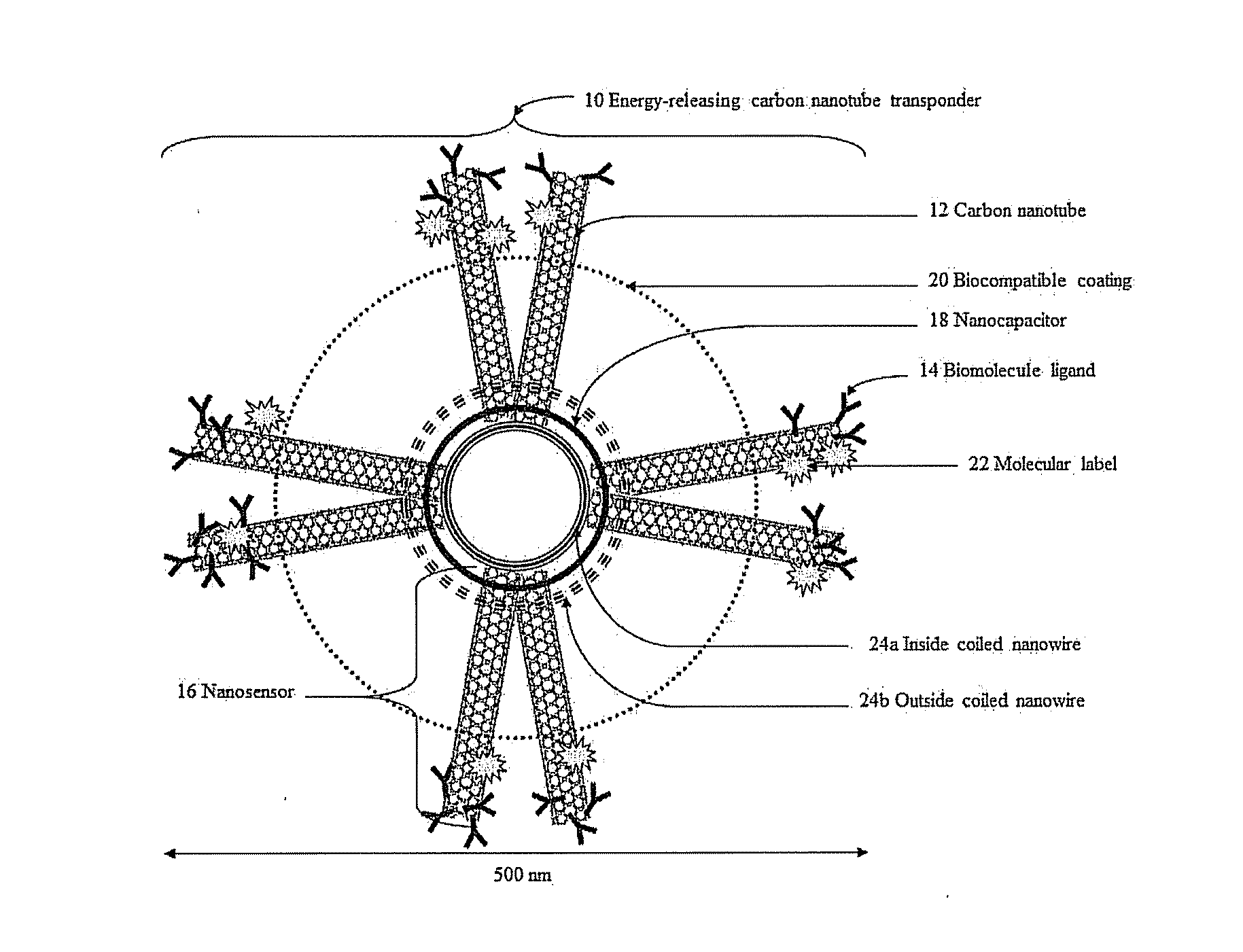Energy-releasing carbon nanotube transponder and method of using same
a carbon nanotube and transponder technology, applied in the field of nanotechnology, can solve the problems of many human patients' afflictions, cancer is presently one of the most difficult fatal conditions to treat, and cancer treatment is unsuccessful,
- Summary
- Abstract
- Description
- Claims
- Application Information
AI Technical Summary
Problems solved by technology
Method used
Image
Examples
example 1
[0079]In the first exemplary embodiment, tumor-specific nanosensors 16 are created to target brain cancer cells named glioblastoma multiforme (GBM). An exemplary marker is interleukin-13R-alpha2 (IL-13Ra2). The nanosensor 16, i.e. SWCNT-IL-13Ra2, is formed by attaching at least one carbon nanotube 12 using noncovalent functionalization, to the IL-13Ra2 biomolecule ligand (i.e. IL-13) 14. See Teker, Bioconjugated carbon nanotubes for targeting cancer biomarkers, Materials Science Engineering 153(1-3):83-87 (2008). The biomolecule ligand 14 specifically binds to the IL-13Ra2 receptors located on the surface of GBM, but not to other receptors. Therefore, the biomolecule ligand 14 located onto the surface of the energy-releasing carbon nanotube transponder 10 allows for its specific binding onto GBM to minimize subsequent damage to healthy non-cancer cells.
[0080]When a biomolecule ligand 14 covalently attached to a carbon nanotube 12 binds to its respective receptor, the conductivity of...
example 2
[0097]In a second exemplary embodiment, a nanosensor 16 is created to detect dynamic alterations in the concentration of the neurotransmitter glutamate generated by neurons surrounding brain neoplastic cells. Such microperturbations of glutamate concentration representing epileptiform activity are used to trigger the release of electric energy from the energy-releasing carbon nanotube transponder 10 into the direct environment of the cells associated with epileptic episodes.
[0098]A nanosensor 16 formed by the attachment of a biomolecule ligand 14 to a carbon nanotube 12 can be introduced into one or more epileptic circuits to detect changes during seizure activity (e.g., femtomolar increases in the neurotransmitter glutamate correlates to an increased conductivity of at least one carbon nanotube 12 of the nanosensor 16). A detection threshold of the energy-releasing carbon nanotube transponder 10 can be used to discharge a nanocapacitor 18 to deliver direct stimulation therapy to po...
example 3
[0117]In a third exemplary embodiment, a carbon nanotube transponder 10 is created to react to dynamic alterations in the concentration of hydrogen ions resulting from cardiac ischemic changes. Acute myocardial ischemia is triggered by insufficient blood flow to the heart. Acute myocardial ischemia, and other heart conditions such as for example ventricular arrhythmias, decrease the level of oxygen and induce anaerobic metabolism within cardiac tissue. Diseases such as, for example, acute myocardial ischemia or ventricular arrhythmias are the direct consequences of a disregulation of the electrical conduction system of the heart.
[0118]To optimize stimulation of cardiac tissue, a plurality of energy-releasing carbon nanotube transponders 10 can be utilized to target specific cardiac cells. Microperturbations in hydrogen ions concentration allow for the detection of anaerobic metabolism due to a lack of oxygen within cardiac tissue. The energy-releasing carbon nanotube transponder 10,...
PUM
 Login to View More
Login to View More Abstract
Description
Claims
Application Information
 Login to View More
Login to View More - R&D
- Intellectual Property
- Life Sciences
- Materials
- Tech Scout
- Unparalleled Data Quality
- Higher Quality Content
- 60% Fewer Hallucinations
Browse by: Latest US Patents, China's latest patents, Technical Efficacy Thesaurus, Application Domain, Technology Topic, Popular Technical Reports.
© 2025 PatSnap. All rights reserved.Legal|Privacy policy|Modern Slavery Act Transparency Statement|Sitemap|About US| Contact US: help@patsnap.com


